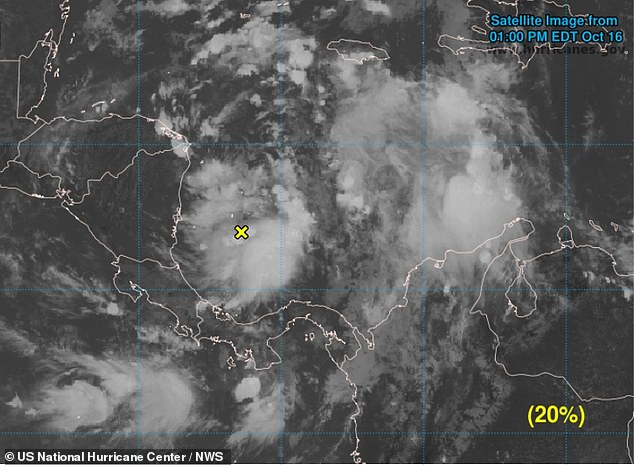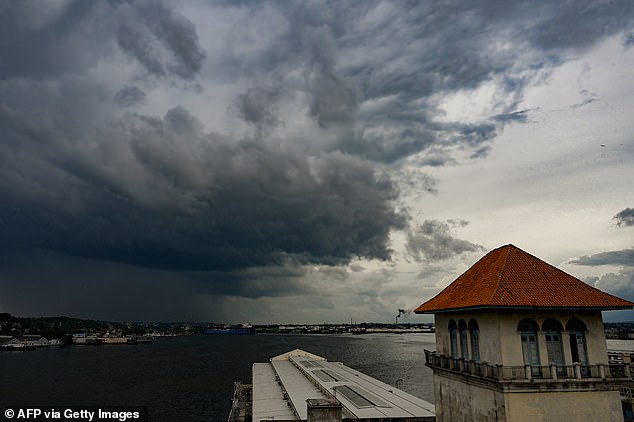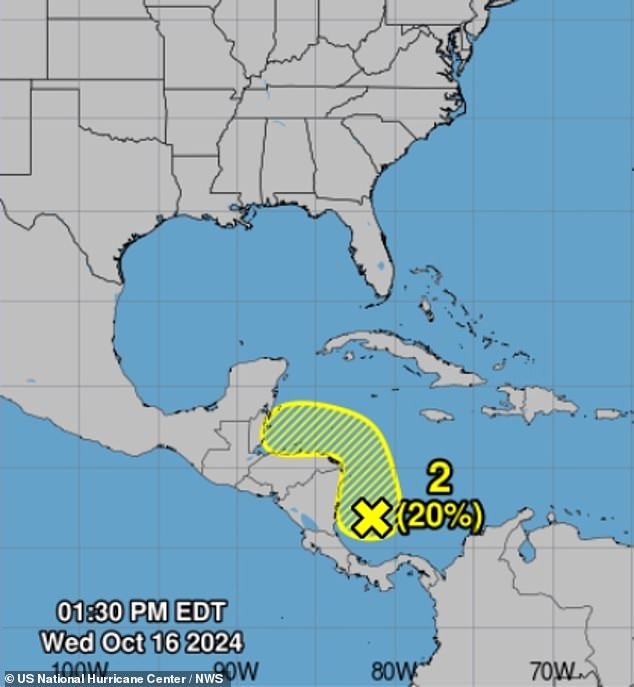Hurricane trackers have identified a new storm brewing in the Caribbean that could become an ‘Oscar’ in the coming days as it gains momentum in the Atlantic.
National Hurricane Center (NHC) branch chief Dan Brown told DailyMail.com that the storm is already on track for “flash flooding and possible landslides,” similar to Hurricane Helene that hit Florida and Carolina northern.
The low pressure system is currently off the coasts of Costa Rica and Panama, producing showers and thunderstorms.
The NHC reported Wednesday that the potential Oscar could “gradually develop if the system remains overwater while slowly moving northwest toward Central America.”
The storm warning comes as potential Tropical Storm ‘Nadine’ is also moving toward the Caribbean and could affect Puerto Rico and the Dominican Republic.
Just a week after Hurricane Milton’s devastating bombardment of Florida, the U.S. National Hurricane Center is tracking a possible new storm over Panama, which will be named “Oscar” if it worsens. Oscar now has a 20 percent chance of becoming a tropical storm in the next seven days.
“The system could organize a little bit as it moves toward Central America over the next few days and could produce some pretty heavy rain,” Brown explained, noting that the effects could be similar to those caused by Hurricane Helene.
But he cautioned that this storm is still shifting, so it’s too early to predict what the true final course of a nascent Oscar might be or where it might wreak the most havoc.
“It’s difficult to say when the peak of the storm will hit because there is a large area of low pressure established over parts of Central America,” Brown warned.
According to the latest NHC report, Oscar now has a 10 percent chance of becoming a tropical storm in the next 48 hours and a 20 percent chance in the next seven days.
an official NHC update Wednesday morning He explained that the storm could become a tropical depression or Tropical Storm Oscar if the system maintains its course.
“Still,” NHC forecasters Dave Zelinsky and Lisa Bucci wrote, “locally heavy rainfall is possible in parts of Central America later this week.”
While NHC models showed the storm’s current track is pointing towards the coast of Belize and Guatemala, Brown told DailyMail.com that wider areas should prepare.
“Portions of Panama, Costa Rica, Nicaragua, Honduras, Belize, Guatemala, El Salvador and potentially parts of southeastern Mexico,” he said.
“It looks like it’s already raining and will probably continue for the next few days,” Brown said.
Tropical depressions, tropical storms and hurricanes are manifestations of the same climatic phenomenon, according to Dr. Mateo Barlowprofessor of environmental, earth, and atmospheric sciences at the University of Massachusetts Lowell.
“The tropical cyclone is the general type of storm,” said Dr. Barlow news week.
‘A tropical depression is a tropical cyclone with maximum winds of 38 mph or less. A tropical storm is a tropical cyclone with maximum winds of 39 to 73 mph. A hurricane is a tropical cyclone with maximum winds of 120 kilometers per hour or more,” he explained.

“The system (yellow and possible landslides. not unlike Hurricane Helene

An official NHC update on Wednesday indicated that the storm could become a tropical depression or worse “if the system remains over water while slowly moving northwest toward Central America.” Above, large clouds over Havana due to Tropical Storm Helene, September 24, 2024
According to the National Oceanic and Atmospheric Administration (NOAA), hurricanes typically develop from tropical waves that combine with warm ocean waters.
Thunderstorms and other atmospheric turbulence can help drive a storm front to build up hurricane strength, as warmer ocean air rises toward these storm clouds, creating an area of low pressure beneath it.
A hurricane’s maximum sustained wind speed, defined as the highest one-minute average wind speed at a particular time, sets the boundary between these powerful storms and minor tropical cyclones.
Florida counties hit hardest by Hurricane Milton reportedly returned to a fragile state of normalcy this week, with power companies restoring electricity to about 93 percent of the 3.4 million homes and businesses that lost service .
Gas stations reopened and students prepared to return to school on Monday, although many neighborhoods still remain without power as they face severely damaged homes and businesses, their streets flooded and littered with debris.
The death toll from Milton currently hovers around 11, compared to the much more definitive death toll from Hurricane Helene, which is now over 240.
The White House has approved more than $1.8 billion for recovery efforts in southern states hit by the double whammy of hurricanes Helene and Milton.


